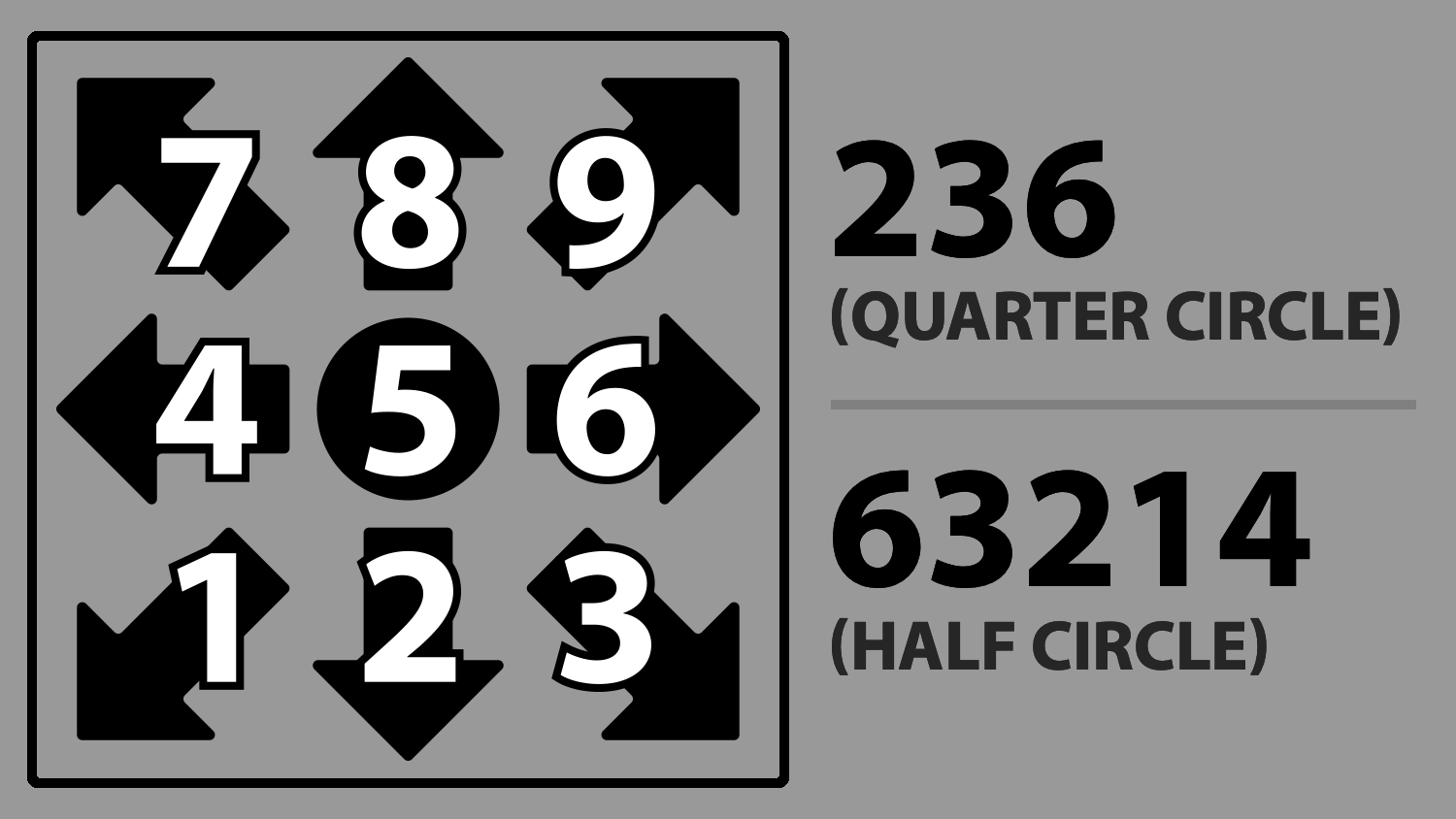Fighting Game Notation
Contents
Fighting games have a lot of different components which help give each game in the genre unique feels & styles. But one of the most fundamental building blocks of a fighting game, even moreso than characters, is the move. Not movement, though that’s also extremely important to fighting game design, but rather the attacks that characters can perform. Since you need to know which moves exist & how to perform them to learn a game, players had to come up with a way of communicating move inputs to others for education & sharing new finds. I’ve spent way too much time thinking about this (I even made a program to convert between different types of notation), so I’ve decided to dump everything anyone would ever need to know about fighting game notation here.
Modifiers⌗
Modifiers are used to show the state that a character needs to be in for a move to work. They prefix the
motion, usually separated by a ., & are abbreviations for what the state is called. Common ones include
j for jumping, & cr for crouching, but there are more and some games have ones specific to them. Tekken
has some of the worst best game-specific ones, like fdft for “Face Down, Feet Towards (opponent)” and
variations for different combinations of face up/down & feet towards/away from the opponent.
Motions⌗
This is the part where notation becomes complicated. It’s less obvious how you should go about notating
motions, so different groups within the FGC came up with different ways of doing it. The 2 prevailing
forms of motion input notation are Abbreviated & Numpad. They have their strengths & weaknesses, but
I’ll try to refrain from saying which one I prefer (though you’ll still probably be able to guess it if
you really want to).
Abbreviated⌗
Abbreviated notation is a notation system that, as the name implies, uses abbreviations to represent different
motions. Directions are measured relative to the opponent rather than as absolute stick positions so that they
stay consistent & unambiguous regardless of which side the character is on - making the directional inputs u
for up, d for down, f for forward, & b for backward. Diagonals are written as the 2 cardinal directions
that they’re composed of, such as df or d/f for down-forward. Different motions also get their own
abbreviations, usually including a direction as many motion inputs can be performed in different directions.
Quarter-circle becomes qcf or qcb for its forwards & backwards variants, half-circle becomes hcf & hcb,
and DP becomes… dp (with rdp for when it’s mirrored). There are of course other motion inputs, but it would
be impossible for me to list everything so you’re gonna have to google around if you want to know more.
This form of notation is used most commonly in Street Fighter & games like it that use 6 attack buttons. Not because 6-button fighters are any more optimised for using abbreviated notation, but because Street Fighter started it & is a 6-button game. It’s also used a lot when speaking moves, even for games that don’t use it, because it’s just super natural to speak out an abbreviation… at least in English. The problem with abbreviated notation is that it’s completely built around English speakers. For anyone that speaks a different language, it’s not intuitive at all and can even be more confusing than another system less optimised for the English language. But it does help that it’s intuitive, even if only to English speakers, because just about anyone can come up with it themselves & it’s extremely easy to understand without much explanation.
Numpad⌗
Numpad notation is much less intuitive than abbreviated notation. It uses digits to represent control stick
positions, with the mappings being based on those digits’ positions on a keyboard’s number pad where 5 is
neutral (no directional input) and is always written assuming the character is facing right. Motions are notated by
simply writing each direction that composes it in sequence - so qcf1 is instead 236 (pronounced “two three
six”). If you don’t have a number pad on hand, damn you, modern laptops here’s a GIF that should help you get
it. Trust me, visualising it really helps.

Numpad notation originated & is primarily used in anime fighters because of its main advantage over abbreviated notation: it’s language-agnostic. Digits are far more universal than abbreviations so, despite being less intuitive for English speakers, it’s more understandable for more people. This is why it caught on more in anime fighting game communities, as they were much less English-speaker-centric than others in the beginning, though that isn’t the case today.
Buttons⌗
The final part of a move is the button you press. This is by far the simplest part - the button is just written
as an abbreviation of whatever the game calls it. Generally, there’s L (Light), M (Medium), & H (Heavy) as
well as P (Punch) & K (Kick). 6-button fighters tend to use L/M/H punches & kicks while 4-button fighters
usually use just L/M/H + S (for Special) or some other random button, or A/B/C/D for Poverty Fighters™️2.
Or they’re Tekken & decide to use 1, 2, 3, & 4 for the different limbs for some reason instead of
abbreviations or just A/B/C/D like normal people, but that’s neither here nor there.
Putting it All Together⌗
With that, you know everything you need to know for you to be able to read any fighting game input you come across. There’s still more to know than this before you become a fighting game deity but now that you’re no longer illiterate, you should be able to read Dustloop, Mizuumi, or any other fighting game wiki or text-based resource with ease. So go forth, my apprentice, and master the arts of the best game genre.